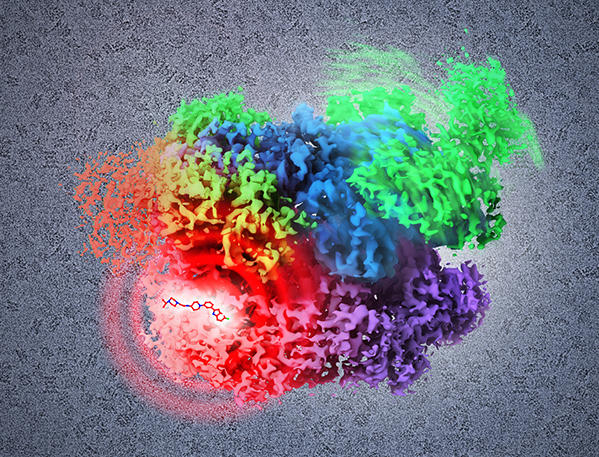New study using cryo-electron microscopy shows how potential drugs could inhibit cancer
- Posted:
240-760-6600

The protein p97 is trapped in an inactive state by a new inhibitor (red) and the molecule cannot proceed into its normal reaction cycle.
Credit: National Cancer Institute
A new study shows that it is possible to use an imaging technique called cryo-electron microscopy (cryo-EM) to view, in atomic detail, the binding of a potential small molecule drug to a key protein in cancer cells. The cryo-EM images also helped the researchers establish, at atomic resolution, the sequence of structural changes that normally occur in the protein, p97, an enzyme critical for protein regulation that is thought to be a novel anti-cancer target.
The study appeared online January 28, 2016, in Science. Sriram Subramaniam, Ph.D., of the National Cancer Institute’s (NCI) Center for Cancer Research, led the research. NCI is part of the National Institutes of Health.
“Cryo-EM is positioned to become an even more useful tool in structural biology and cancer drug development,” said Douglas Lowy, M.D., acting director, NCI. “This latest finding provides a tantalizing possibility for advancing effective drug development.”
To determine structures by cryo-EM, protein suspensions are flash-frozen at very low temperatures; nevertheless, the water around the protein molecules stays liquid-like. The suspensions are then bombarded with electrons to capture their images. To produce three-dimensional protein structures using cryo-EM, researchers generate thousands of two-dimensional images of the molecules in different orientations, which are then averaged together. This type of imaging procedure has gained in popularity in structural biology research because it allows for the observation of specimens that have not been stained or fixed in any way, enabling visualization of the specimens under near-native, or natural, conditions.
Earlier structural studies of full-length p97 by a well-established technique known as X-ray crystallography have been limited so far to medium resolution (3.5 Å to 4.7 Å). With cryo-EM, however, researchers were able to image full-length p97 at an overall resolution of 2.3 Å, which is much finer, allowing them to visualize key regions of the protein in atomic detail.
Most significantly, the mode of binding and contact sites of a small molecule inhibitor of p97 activity could be observed directly. Drug development efforts often involve mapping the contacts between small molecules and their binding sites on specific proteins. With this latest finding, the resolutions achieved were significant enough to discern both the shape of the protein chain and some of the hydrogen bonds between the protein and the small molecule inhibitor.
“Our latest research provides new insights into the protein structures and interactions that are critical for the activity of a cancer cell, and this knowledge will hopefully enable the design of clinically useful drugs,” said Subramaniam.
Subramaniam and colleagues recently used cryo-EM to understand the functioning of a variety of molecules, including proteins and receptors found in brain cells. The level of detail achieved in their new study however, resolutions of 2.3 Å and 2.4 Å for p97 with and without the bound inhibitor, are second only the 2.2 Å resolution structure reported last year in Science for an enzyme, also by the same group of NCI researchers.